軍事的諜報
military intelligence, インテリジェンス、諜報(ちょうほう), 軍事情報
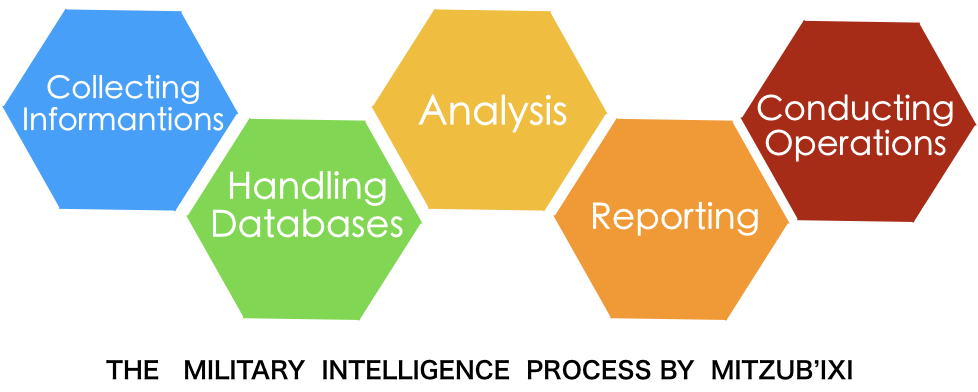
軍事的諜報
military intelligence, インテリジェンス、諜報(ちょうほう), 軍事情報

——日本語の「情報」という言葉は、英語の
information 及び intelligence
の両方の訳語として使われているため、それぞれの意味が混在している。つまり欧米の有識者の間では明確に区別されている両者の使い分けがなされていないの
が現状である。「序文」『インテリジェンス用語辞典』並木書房, 2022年.
インテリジェンス(intelligence)と は、軍事あるいは現実政治(リアルポリティーク)の世界で、秘密裏にすすめられる、 人または通信や機械(コンピュータ)を使っておこなわれる、情報の収集、蓄 積、分析、解析の報告からなる活動である。インテリジェンスは かつて、諜報(ちょ うほう)と翻訳されていたことばを外来語として読み直したものである。Google - Dictionary によると二番目の意味に、2. the collection of information of military or political value(=軍事的または政治的価値のある情報収集).とあり、その同義語(synonyms)として「 information gathering(情報の収集), surveillance(監視), observation(観察), reconnaissance(偵察), spying(スパイ行為), espionage(スパイ活動), undercover work(諜報), infiltration(潜入[調査]), ELINT(電子偵察:electronic intelligenceの略号), HUMINT(人間諜報活動:Human intelligence), cyberespionage(サイバースパイ活動), humint(情報分析)」からなる。(→「インテリジェンス (intelligence)」)
これらをまとめると、軍事あるいは現実政治(リアルポ リティーク)の世界で、秘密裏にすすめられる、人または通信や 機械(コンピュータ)を使っておこなわれる、(1)情報の収集、(2)蓄積、(3)分析、(4)報告、そしてそれに基づく(5)作戦遂行、の5要素が諜報 =インテリジェンス[intelligence](あるいは軍事的インテリジェンス:military intelligence)である。(上掲のヘクサゴン)
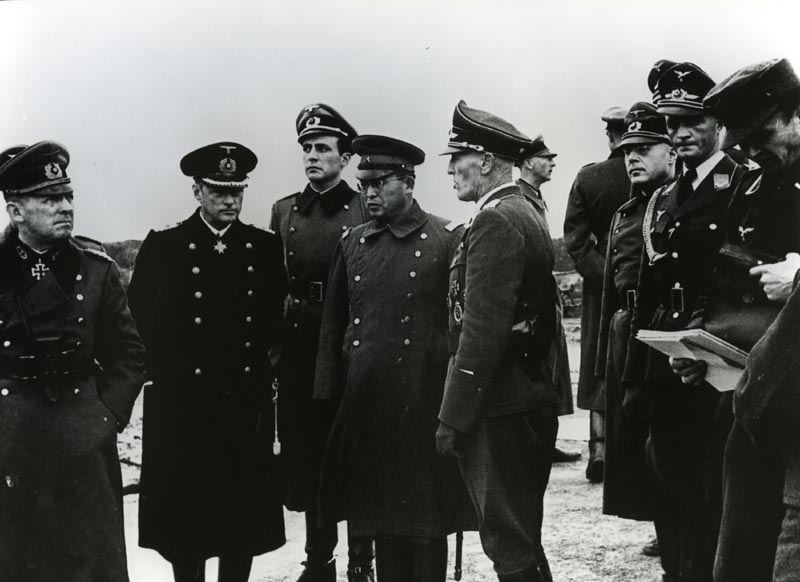 |
1942年12月、ドイツ陸軍上級大将(第21軍 司令官ニコラウス・フォン・ファルケンホルスト、左端)以下、独陸海空軍の 将校らと写る小野寺信(中央)※ファルケンホルストの戦後の戦犯助命嘆願に探検家ヘディンが動いたとのこと。日本陸軍のソ連作戦の防諜のことをしらべてい て、小野寺信との写真があるので、ここに到達する。小野寺はその後SD国外諜報局長であるヴァルター・シェレンベルクとも交流する。 |
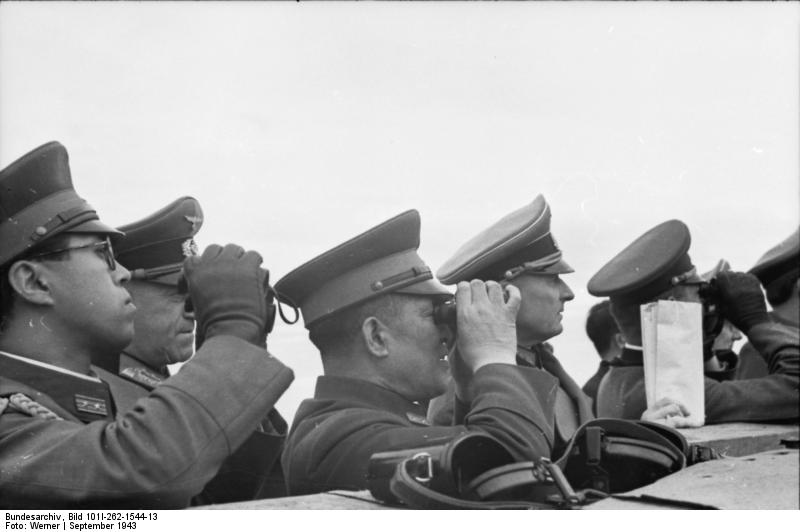 |
南フランスのドイツ軍防衛拠点を視察中の大島浩大佐=駐独大使(1938-1945)(写真中央、1943年9月)
Bundesarchiv, Bild 101I-262-1544-13 / Werner / CC-BY-SA 3.0 ウィリアム・L・シャイラーは大島を「ナチス以上の国家社会主義者」と評し, 「1945年(昭和20年)に至っても、日本政府は駐スイス公使阪本瑞男からのドイツ第三帝国瓦解との本国電を黙殺、大島浩(Hiroshi OSHIMA, 1886-1975)によるドイツ有利との誤った戦況報告を重用し続けた。ドイツを一方的に信じ続けた大島によるそれらの暗号電報は、全て連合国側に解読 されており、英米の作戦遂行に有利に活用されていた」 九七式欧文印字機=暗号機B型(PURPLE, Type B Cipher Machine) |
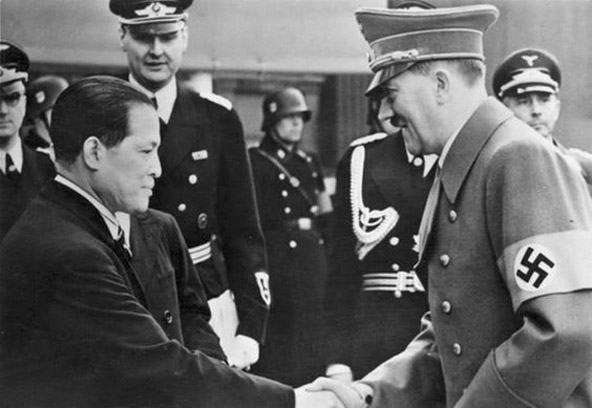 |
Adolf Hitler meeting Japanese
ambassador to Germany Hiroshi Ōshima (from, Racial
policy of Nazi Germany) |
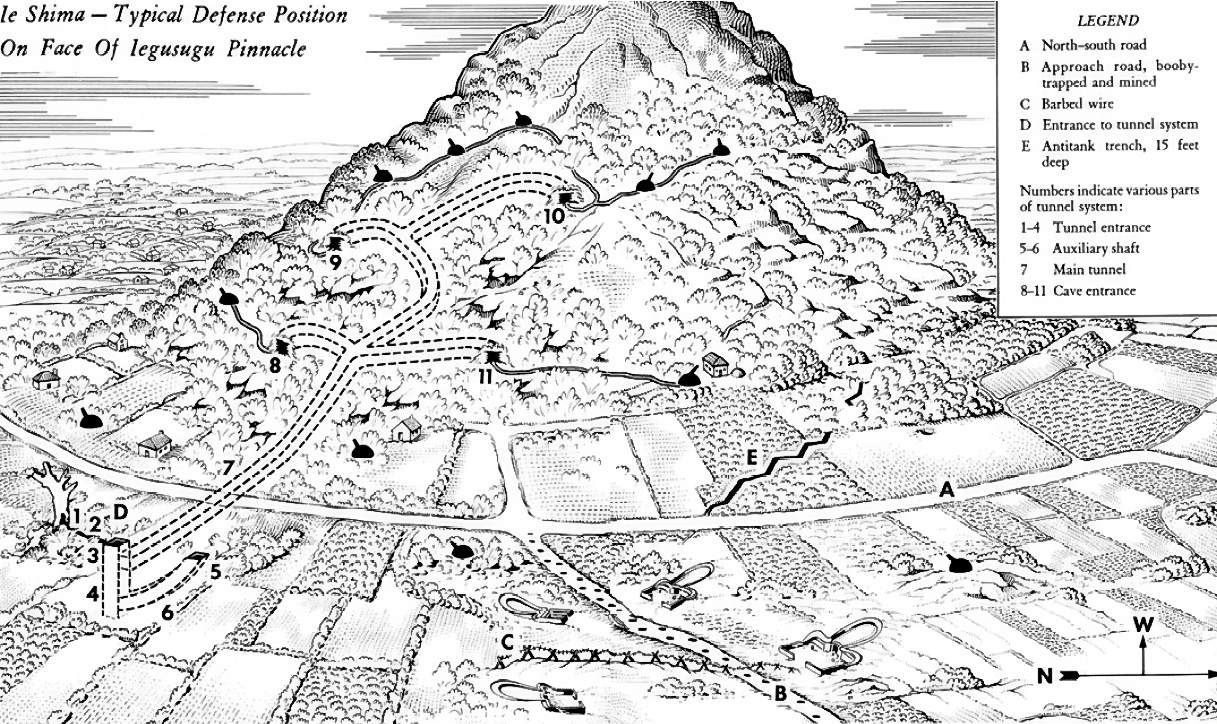 |
Military intelligence diagram of defense positions during the Battle of Okinawa, 1945. |
 |
●インテリジェンスの技法と分析
プロファイリング (Offender profiling, criminal profiling) とは、犯罪捜査において犯罪の性質や特徴から行動科学的に分析し、犯人の特徴を推論すること。ここから派生して、プロファイリング一般の意味とは、目標に する人物の行動パターンや特徴からプロファルを収集し、その人物の属性や帰属集団、そして、未来の行動を推論することである。
●日本における諜報戦略の失敗の原因 (Barnhart 1984: 441)
1)あらゆる政策決定における諜報機関の従属的な位 置
2)日本政府および諜報機関が活動しなければならな
い時間が短期間に終わったということ
"In all three cases,
Japan's intelligence failures stemmed from two
factors. One was the subordinate position of the intelligence organs
in any policy-making process. The other was the excessively narrow
focus within those organs and the Japanese government as a whole
on purely short-term, operational matters. The existence of either
factor alone would have practically guaranteed that Japanese opponents
of the decision to commence the Pacific war would have
had a difficult time winning their case. The existence of both ensured
that those few opponents did not even receive a hearing."
★インテリジェンスの基礎知識(https://en.wikipedia.org/wiki/Military_intelligence)
| Military
intelligence is a military discipline that uses information
collection and analysis approaches to provide guidance and direction to
assist commanders in their decisions.[1] This aim is achieved by
providing an assessment of data from a range of sources, directed
towards the commanders' mission requirements or responding to questions
as part of operational or campaign planning. To provide an analysis,
the commander's information requirements are first identified, which
are then incorporated into intelligence collection, analysis, and
dissemination. Areas of study may include the operational environment, hostile, friendly and neutral forces, the civilian population in an area of combat operations, and other broader areas of interest.[2] Intelligence activities are conducted at all levels, from tactical to strategic, in peacetime, the period of transition to war, and during a war itself. Most governments maintain a military intelligence capability to provide analytical and information collection personnel in both specialist units and from other arms and services. The military and civilian intelligence capabilities collaborate to inform the spectrum of political and military activities. Personnel performing intelligence duties may be selected for their analytical abilities and personal intelligence before receiving formal training. |
軍事情報とは、情報収集と分析のアプローチを用いて、指揮官の意思決定
を支援するための指針と指示を提供する軍事分野である[1]。この目的は、指揮官の任務要件に向けた、または作戦・キャンペーン計画の一環としての質問に
答えるために、さまざまな情報源からのデータの評価を提供することで達成される。分析を行うには、まず司令官の情報要件を特定し、それを情報収集、分析、
発信に反映させる。 調査対象には、作戦環境、敵対・友好・中立勢力、戦闘作戦地域の民間人、その他より広範な関心領域が含まれる[2]。情報活動は、戦術から戦略まで、平 時、戦争への移行期、戦争中のすべてのレベルで実施される。 ほとんどの政府は、専門部隊と他の兵器やサービスから分析および情報収集要員を提供する軍事情報能力を保持している。軍と民間の情報能力は、政治的・軍事 的活動の範囲に情報を提供するために協力し合う。 諜報活動を行う人員は、正式な訓練を受ける前に、その分析能力と個人的な情報によって選抜されることがある。 |
| Intelligence operations are
carried out throughout the hierarchy of political and military activity. Strategic Strategic intelligence is concerned with broad issues such as economics, political assessments, military capabilities and intentions of foreign nations (and, increasingly, non-state actors).[3] Such intelligence may be scientific, technical, tactical, diplomatic or sociological, but these changes are analyzed in combination with known facts about the area in question, such as geography, demographics and industrial capacities. Strategic Intelligence is formally defined as "intelligence required for the formation of policy and military plans at national and international levels", and corresponds to the Strategic Level of Warfare, which is formally defined as "the level of warfare at which a nation, often as a member of a group of nations, determines national or multinational (alliance or coalition) strategic security objectives and guidance, then develops and uses national resources to achieve those objectives." |
諜報活動は、政治的・軍事的活動の階層を通じて行われる。 戦略的 戦略的諜報活動は、経済、政治的評価、軍事能力、外国(最近では非国家主体も)の意図など幅広い問題に関わる[3]。こうした諜報活動は、科学、技術、戦 術、外交、社会学的であっても、地理、人口統計、産業能力など当該地域に関する既知の事実と組み合わせて分析される。 戦略的インテリジェンスとは、正式には「国家および国際レベルでの政策および軍事計画の形成に必要な情報」と定義され、「戦争の戦略的レベル」に相当す る。"国家が、しばしば国家群の一員として、国家または多国間(同盟または連合)の戦略的安全保障目的と指針を決定し、次にそれらの目的を達成するために 国家資源を開発および使用する戦争のレベル "と正式には定義される。 |
| Operational Operational intelligence is focused on support or denial of intelligence at operational tiers. The operational tier is below the strategic level of leadership and refers to the design of practical manifestation. Formally defined as "Intelligence that is required for planning and conducting campaigns and major operations to accomplish strategic objectives within theaters or operational areas."[4] It aligns with the Operational Level of Warfare, defined as "The level of warfare at which campaigns and major operations are planned, conducted, and sustained to achieve strategic objectives within theaters or other operational areas."[4] The term operation intelligence is used within law enforcement to refer to intelligence that supports long-term investigations into multiple, similar targets. Operational intelligence, in the discipline of law enforcement intelligence, is concerned primarily with identifying, targeting, detecting and intervening in criminal activity. The use within law enforcement and law enforcement intelligence is not scaled to its use in general intelligence or military/naval intelligence, being more narrowed in scope. |
作戦情報 オペレーショナル・インテリジェンスは、作戦層におけるインテリジェンスの支援または拒否に重点を置いています。作戦層は戦略レベルの指導者より下にあ り、実際的な顕在化の設計を意味する。正式には「劇場または作戦地域内で戦略目標を達成するために、キャンペーンおよび主要な作戦を計画・実施するために 必要な情報」と定義され[4]、「劇場またはその他の作戦地域内で戦略目標を達成するためにキャンペーンおよび主要な作戦が計画・実施・維持される戦争の レベル」と定義される「戦争の運用レベル」と一致している[4]。 オペレーション・インテリジェンスという用語は、法執行機関において、複数の類似のターゲットに対する長期的な捜査を支援するインテリジェンスを指すため に使用されている。法執行情報という分野でのオペレーション・インテリジェンスは、主に犯罪活動の特定、標的、検出、介入に関わるものである。法執行機関 および法執行情報内での使用は、一般的な情報または軍事/海軍情報での使用とは規模が異なり、より狭い範囲に限定されています。 |
| Tactical Tactical intelligence is focused on support to operations at the tactical level and would be attached to the battlegroup. At the tactical level, briefings are delivered to patrols on current threats and collection priorities. These patrols are then debriefed to elicit information for analysis and communication through the reporting chain.[5] Tactical Intelligence is formally defined as "intelligence required for the planning and conduct of tactical operations", and corresponds with the Tactical Level of Warfare, itself defined as "the level of warfare at which battles and engagements are planned and executed to achieve military objectives assigned to tactical units or task forces".[citation needed] |
タクティカル(戦術的) 戦術情報とは、戦術レベルでの作戦支援に焦点を当てたもので、戦闘部隊に所属することになる。戦術レベルでは、現在の脅威と収集の優先順位についてパト ロールにブリーフィングが行われる。これらのパトロールはその後、報告連鎖を通じて分析および通信のための情報を引き出すためにブリーフィングされる [5]。 戦術情報とは、正式には「戦術作戦の計画と実施に必要な情報」と定義され、「戦術ユニットまたはタスクフォースに割り当てられた軍事目標を達成するために 戦闘と交戦が計画・実行される戦争のレベル」と定義される戦術レベルの戦争に対応している[引用者注釈]. |
| Tasking Intelligence should respond to the needs of leadership, based on the military objective and operational plans. The military objective provides a focus for the estimate process, from which a number of information requirements are derived. Information requirements may be related to terrain and impact on vehicle or personnel movement, disposition of hostile forces, sentiments of the local population and capabilities of the hostile order of battle. In response to the information requirements, analysts examine existing information, identifying gaps in the available knowledge. Where gaps in knowledge exist, the staff may be able to task collection assets to target the requirement. Analysis reports draw on all available sources of information, whether drawn from existing material or collected in response to the requirement. The analysis reports are used to inform the remaining planning staff, influencing planning and seeking to predict adversary intent. This process is described as Collection Co-ordination and Intelligence Requirement Management (CCIRM). |
任務遂行 インテリジェンスは、軍事目標と作戦計画に基づき、指導者のニーズに応える必要がある。軍事目的は見積もりプロセスの焦点となり、そこから多くの情報要件 が導き出される。情報要件は、地形や車両や人員の移動への影響、敵対勢力の配置、現地住民の感情、敵対勢力の戦闘順位の能力などに関連することがある。 情報要件に対応するため、アナリストは既存の情報を調査し、利用可能な知識におけるギャップを特定する。知識のギャップが存在する場合、スタッフは収集資 産にタスクを与えて要件を満たすことができる。 分析報告書は、既存の資料から引き出されたものであれ、要件に対応して収集されたものであれ、利用可能なすべての情報源に依拠する。分析報告書は、残りの 計画担当者に情報を提供し、計画に影響を与え、敵の意図を予測するために使用される。 このプロセスは、CCIRM(Collection Co-ordination and Intelligence Requirement Management)と呼ばれている。 |
| Process The process of intelligence has four phases: collection, analysis, processing and dissemination. In the United Kingdom these are known as direction, collection, processing and dissemination. In the U.S. military, Joint Publication 2-0 (JP 2-0) states: "The six categories of intelligence operations are: planning and direction; collection; processing and exploitation; analysis and production; dissemination and integration; and evaluation and feedb |
プロセス インテリジェンスのプロセスには、収集、分析、処理、普及の4つの段階があります。 イギリスでは、これらを「指示、収集、処理、普及」と呼んでいる。 米軍では、Joint Publication 2-0 (JP 2-0)にこう書かれています: 「情報活動の6つのカテゴリーとは、計画と指示、収集、処理と搾取、分析と生産、普及と統合、そして評価とフィードバックである。 |
| Collection Many of the most important facts are well known or may be gathered from public sources. This form of information collection is known as open-source intelligence. For example, the population, ethnic make-up and main industries of a region are extremely important to military commanders, and this information is usually public. It is however imperative that the collector of information understands that what is collected is "information", and does not become intelligence until after an analyst has evaluated and verified this information. Collection of read materials, composition of units or elements, disposition of strength, training, tactics, personalities (leaders) of these units and elements contribute to the overall intelligence value after careful analysis. The tonnage and basic weaponry of most capital ships and aircraft are also public, and their speeds and ranges can often be reasonably estimated by experts, often just from photographs. Ordinary facts like the lunar phase on particular days or the ballistic range of common military weapons are also very valuable to planning, and are habitually collected in an intelligence library. A great deal of useful intelligence can be gathered from photointerpretation of detailed high-altitude pictures of a country. Photointerpreters generally maintain catalogs of munitions factories, military bases and crate designs in order to interpret munition shipments and inventories. Most intelligence services maintain or support groups whose only purpose is to keep maps. Since maps also have valuable civilian uses, these agencies are often publicly associated or identified as other parts of the government. Some historic counterintelligence services, especially in Russia and China, have intentionally banned or placed disinformation in public maps; good intelligence can identify this disinformation. It is commonplace for the intelligence services of large countries to read every published journal of the nations in which it is interested, and the main newspapers and journals of every nation. This is a basic source of intelligence. It is also common for diplomatic and journalistic personnel to have a secondary goal of collecting military intelligence. For western democracies, it is extremely rare for journalists to be paid by an official intelligence service, but they may still patriotically pass on tidbits of information they gather as they carry on their legitimate business. Also, much public information in a nation may be unavailable from outside the country. This is why most intelligence services attach members to foreign service offices. Some industrialized nations also eavesdrop continuously on the entire radio spectrum, interpreting it in real time. This includes not only broadcasts of national and local radio and television, but also local military traffic, radar emissions and even microwaved telephone and telegraph traffic, including satellite traffic. The U.S. in particular is known to maintain satellites that can intercept cell-phone and pager traffic, usually referred to as the ECHELON system. Analysis of bulk traffic is normally performed by complex computer programs that parse natural language and phone numbers looking for threatening conversations and correspondents. In some extraordinary cases, undersea or land-based cables have been tapped as well. More exotic secret information, such as encryption keys, diplomatic message traffic, policy and orders of battle are usually restricted to analysts on a need-to-know basis in order to protect the sources and methods from foreign traffic analysis. |
コレクション 最も重要な事実の多くは、よく知られているか、または公的な情報源から収集することができます。このような情報収集の形態は、オープンソースインテリジェ ンスとして知られています。例えば、ある地域の人口、民族構成、主要産業などは、軍司令官にとって極めて重要であり、この情報は通常公開されている。しか し、情報収集者は、収集されたものは「情報」であり、分析者がその情報を評価・検証して初めて情報となることを理解することが必要である。資料の収集、部 隊や要素の構成、兵力の配置、訓練、戦術、これらの部隊や要素の性格(リーダー)は、慎重に分析した後、全体的な情報価値に貢献します。 ほとんどの資本船や航空機のトン数や基本的な兵器も公開されており、その速度や航続距離は、多くの場合、写真からだけで、専門家が合理的に推定することが できます。特定の日の月の満ち欠けや、一般的な軍事兵器の弾道距離のような普通の事実も、計画を立てる上で非常に価値があり、情報図書館に常備されてい る。 高高度で撮影された詳細な写真から、多くの有用な情報を収集することができる。写真判読者は一般に、軍需品の出荷や在庫を判読するために、軍需工場や軍事 基地、木箱のデザインなどのカタログを保持している。 ほとんどの諜報機関は、地図を保管することだけを目的としたグループを維持または支援している。地図には貴重な民間利用もあるため、これらの機関はしばし ば政府の他の部分と公に関連づけられたり、識別されたりします。歴史的な防諜機関、特にロシアと中国の防諜機関の中には、公共の地図に偽情報を意図的に禁 じたり置いたりしているものがあります。 大国の諜報機関は、関心を持つ国の出版された雑誌をすべて読むのは当たり前で、どの国の主要な新聞や雑誌も読んでいます。これは基本的な情報源である。 また、外交官やジャーナリズム関係者が、軍事情報の収集という二次的な目的を持つこともよくあることです。西側民主主義国家の場合、ジャーナリストが公的 な情報機関から報酬を得ることは極めて稀であるが、それでも愛国心から、正当な業務を遂行する中で得た情報の断片を伝えることはある。また、ある国の公共 情報の多くは、国外から入手することができない場合がある。そのため、多くの情報機関では、外務省に職員を派遣している。 また、先進国の中には、電波の全領域を継続的に盗聴し、リアルタイムで解釈している国もあります。これには、国や地域のラジオやテレビの放送だけでなく、 地域の軍事トラフィック、レーダー放射、さらには衛星トラフィックを含むマイクロ波電話や電信のトラフィックも含まれます。 特に米国では、携帯電話やポケベルの通信を傍受できる衛星を保有していることが知られており、通常エシュロンシステムと呼ばれている。大量のトラフィック の解析は、通常、自然言語や電話番号を解析し、脅迫的な会話や通信相手を探す複雑なコンピュータープログラムによって行われます。特別なケースでは、海底 や陸上のケーブルも盗聴されることがある。 暗号化キー、外交メッセージトラフィック、政策、戦闘命令など、よりエキゾチックな秘密情報は、外国のトラフィック分析からソースと方法を保護するため に、通常、知る必要があるベースでアナリストに制限されています。 |
| Analysis Analysis consists of assessment of an adversary's capabilities and vulnerabilities. In a real sense, these are threats and opportunities. Analysts generally look for the least defended or most fragile resource that is necessary for important military capabilities. These are then flagged as critical vulnerabilities. For example, in modern mechanized warfare, the logistics chain for a military unit's fuel supply is often the most vulnerable part of a nation's order of battle. Human intelligence, gathered by spies, is usually carefully tested against unrelated sources. It is notoriously prone to inaccuracy. In some cases, sources will just make up imaginative stories for pay, or they may try to settle grudges by identifying personal enemies as enemies of the state that is paying for the intelligence. However, human intelligence is often the only form of intelligence that provides information about an opponent's intentions and rationales, and it is therefore often uniquely valuable to successful negotiation of diplomatic solutions. In some intelligence organizations, analysis follows a procedure. First, general media and sources are screened to locate items or groups of interest, and then their location, capabilities, inputs and environment are systematically assessed for vulnerabilities using a continuously-updated list of typical vulnerabilities. |
分析 分析とは、敵の能力と脆弱性を評価することである。本当の意味で、これらは脅威と機会である。アナリストは一般に、重要な軍事能力に必要な、最も防御力の 低い資源や最も脆弱な資源を探します。そして、これらは重要な脆弱性としてフラグが立てられます。例えば、現代の機械化戦争では、軍隊の燃料供給のための ロジスティクスチェーンは、しばしば国家の戦闘秩序の中で最も脆弱な部分となる。 スパイが収集したヒューマン・インテリジェンスは、通常、無関係な情報源と慎重に照合されます。しかし、その情報は不正確であることが多い。場合によって は、情報源は報酬のために想像力豊かなストーリーを作り上げたり、個人的な敵を情報料を支払っている国家の敵として特定することで恨みを晴らそうとしたり することもある。しかし、ヒューマン・インテリジェンスは、相手の意図や根拠に関する情報を提供する唯一の情報であることが多く、それゆえ、外交的解決策 の交渉を成功させるために唯一無二の価値を持つことが多い。 ある情報機関では、分析はある手順で行われる。まず、一般的なメディアや情報源を選別し、関心のある項目やグループを探し出し、その場所、能力、入力、環 境について、継続的に更新される典型的な脆弱性リストを用いて脆弱性を系統的に評価する。 |
| Filing Critical vulnerabilities are then indexed in a way that makes them easily available to advisors and line intelligence personnel who package this information for policy-makers and war-fighters. Vulnerabilities are usually indexed by the nation and military unit with a list of possible attack methods. Critical threats are usually maintained in a prioritized file, with important enemy capabilities analyzed on a schedule set by an estimate of the enemy's preparation time. For example, nuclear threats between the USSR and the U.S. were analyzed in real time by continuously on-duty staffs. In contrast, analysis of tank or army deployments are usually triggered by accumulations of fuel and munitions, which are monitored every few days. In some cases, automated analysis is performed in real time on automated data traffic. Packaging threats and vulnerabilities for decision-makers is a crucial part of military intelligence. A good intelligence officer will stay very close to the policy-maker or war fighter to anticipate their information requirements and tailor the information needed. A good intelligence officer will also ask a fairly large number of questions in order to help anticipate needs. For an important policy-maker, the intelligence officer will have a staff to which research projects can be assigned. Developing a plan of attack is not the responsibility of intelligence, though it helps an analyst to know the capabilities of common types of military units. Generally, policy-makers are presented with a list of threats and opportunities. They approve some basic action, and then professional military personnel plan the detailed act and carry it out. Once hostilities begin, target selection often moves into the upper end of the military chain of command. Once ready stocks of weapons and fuel are depleted, logistic concerns are often exported to civilian policy-makers. |
ファイリング 重要な脆弱性は、政策立案者や戦闘員のためにこの情報をパッケージ化するアドバイザーやラインインテリジェンス担当者が容易に利用できるようにインデック ス化されています。脆弱性は通常、国家と軍事単位でインデックス化され、可能性のある攻撃方法のリストが添付されます。 重要な脅威は通常、優先順位付けされたファイルで管理され、敵の準備時間の見積もりによって設定されたスケジュールで、重要な敵の能力を分析します。例え ば、ソ連とアメリカの核の脅威は、当直のスタッフが継続的にリアルタイムで分析した。一方、戦車や軍隊の配備状況の分析は、通常、燃料や弾薬の蓄積をきっ かけに、数日おきに監視されることになる。場合によっては、自動化されたデータトラフィックに対してリアルタイムで自動解析が行われることもある。 脅威と脆弱性を意思決定者のためにパッケージ化することは、軍事情報の重要な部分である。優秀な情報将校は、政策立案者や戦闘員の近くにいて、彼らの情報 要件を予測し、必要な情報を調整することができる。また、優れた情報将校は、ニーズを予測するために、かなり多くの質問をする。重要な政策立案者であれ ば、情報将校は研究プロジェクトを割り当てることができるスタッフを持っている。 攻撃計画の策定は情報部の責任ではないが、一般的な軍事ユニットの能力を知っておくことはアナリストの助けになる。一般に、政策決定者には脅威と機会のリ ストが提示される。政策決定者は何らかの基本的な行動を承認し、次に専門の軍事関係者が詳細な行動を計画し、それを実行する。敵対行為が始まると、標的の 選定はしばしば軍の指揮系統の上層部に移行する。武器や燃料の備蓄が尽きると、ロジスティクスに関する懸念は、民間の政策立案者に委ねられることが多い。 |
| Dissemination The processed intelligence information is disseminated through database systems, intel bulletins and briefings to the different decision-makers. The bulletins may also include consequently resulting information requirements and thus conclude the intelligence cycle. |
情報発信 処理されたインテリジェンス情報は、データベースシステム、インテリジェンス速報、ブリーフィングなどを通じて、さまざまな意思決定者に配布される。速報 には、結果的に必要となる情報が含まれることもあり、情報サイクルは終了する。 |
| Military intelligence
organisations See also: List of intelligence agencies Defence Intelligence Organisation (Australia) Intelligence Branch (Canadian Forces) Military Intelligence (Czech Republic) Direction du Renseignement Militaire (France) Bundesnachrichtendienst (BND – German Federal Intelligence Service) and Militärischer Abschirmdienst (MAD- German Military Counter-Intelligence) Directorate General of Forces Intelligence (Bangladesh) Strategic Intelligence Agency (Indonesia) Defence Intelligence Agency (India) Directorate of Military Intelligence (Ireland) Inter-Services Intelligence and Military Intelligence of Pakistan Centro de Informações e Segurança Militares (CISMIL – Portugal) Glavnoye Razvedyvatel'noye Upravleniye (GRU – Russian Military Intelligence) Military Intelligence Agency (VOA – Serbia) Defence Intelligence and the Intelligence Corps (UK) United States Intelligence Community Defense Intelligence Agency G-2, US Army unit Defence Intelligence (SANDF) (South Africa) |
軍事情報組織 も参照のこと: 情報機関の一覧 国防情報局(オーストラリア) 情報部(カナダ軍) 軍情報部(チェコ共和国) 軍事情報局(フランス) ドイツ連邦情報局(Bundesnachrichtendienst)およびドイツ防諜局(MAD:Militärischer Abschirmdienst) 軍情報総局(バングラデシュ) 戦略情報局(インドネシア) 国防情報局(インド) 軍情報総局(アイルランド) パキスタン軍情報部(Inter-Services Intelligence and Military Intelligence of Pakistan 情報セキュリティ・センター(CISMIL、ポルトガル) GRU(ロシア軍事情報局) 軍情報局(VOA-セルビア) 国防情報部および情報部隊(英国) 米国情報コミュニティ 国防情報局 G-2(米陸軍部隊 国防情報局(SANDF)(南アフリカ) |
| https://en.wikipedia.org/wiki/Military_intelligence |
Military intelligence
diagram of defense positions during the Battle of Okinawa, 1945.
リンク
文献
その他の情報
Copyleft, CC, Mitzub'ixi Quq Chi'j, 1996-2099
Copyleft,
CC, Mitzub'ixi Quq Chi'j, 1996-2099